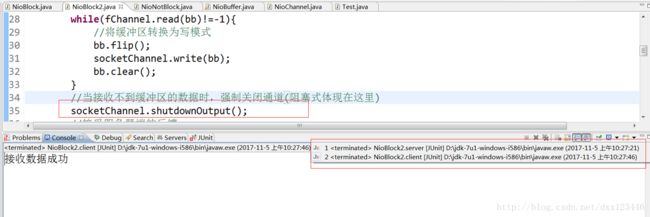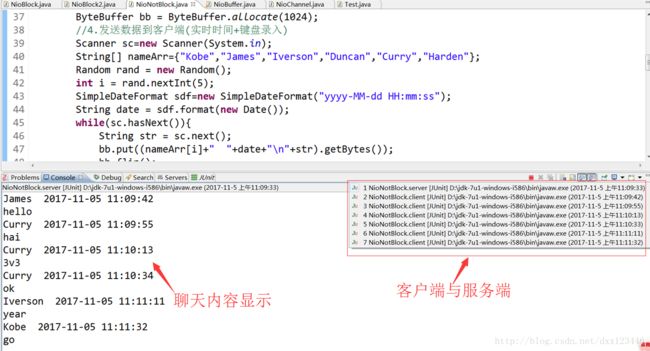Java NIO及其常用API
一、初识NIO
> 在 JDK 1. 4 中 新 加入 了 NIO( New Input/ Output) 类, 引入了一种基于通道和缓冲区的 I/O 方式,它可以使用 Native 函数库直接分配堆外内存,然后通过一个存储在 Java 堆的 DirectByteBuffer 对象作为这块内存的引用进行操作,避免了在 Java 堆和 Native 堆中来回复制数据。NIO 是一种同步非阻塞的 IO 模型。同步是指线程不断轮询 IO 事件是否就绪,非阻塞是指线程在等待 IO 的时候,可以同时做其他任务。同步的核心就是 Selector,Selector 代替了线程本身轮询 IO 事件,避免了阻塞同时减少了不必要的线程消耗;非阻塞的核心就是通道和缓冲区,当 IO 事件就绪时,可以通过写道缓冲区,保证 IO 的成功,而无需线程阻塞式地等待。
在NIO中有几个比较关键的概念:Buffer(缓冲区),Channel(通道),Selector(选择器)。
Buffer(缓冲区):
在Java NIO中负责数据的存取,缓冲区就是数组,用于存储不同类型的缓冲区。为什么说NIO是基于缓冲区的IO方式呢?因为,当一个链接建立完成后,IO的数据未必会马上到达,为了当数据到达时能够正确完成IO操作,在BIO(阻塞IO)中,等待IO的线程必须被阻塞,以全天候地执行IO操作。为了解决这种IO方式低效的问题,引入了缓冲区的概念,当数据到达时,可以预先被写入缓冲区,再由缓冲区交给线程,因此线程无需阻塞地等待IO。
Channel(通道):
用于源节点与目标节点的连接,在java NIO 中负责缓冲区中的数据传输,Channel本身不存储数据,因此需要缓冲区配合进行传输,通道就相当于铁轨,缓冲区就相当于火车。
引用 Java NIO 中权威的说法:通道是 I/O 传输发生时通过的入口,而缓冲区是这些数 据传输的来源或目标。对于离开缓冲区的传输,您想传递出去的数据被置于一个缓冲区,被传送到通道。对于传回缓冲区的传输,一个通道将数据放置在您所提供的缓冲区中。
例如 有一个服务器通道 ServerSocketChannel serverChannel,一个客户端通道 SocketChannel clientChannel;服务器缓冲区:serverBuffer,客户端缓冲区:clientBuffer。
当服务器想向客户端发送数据时,需要调用:clientChannel.write(serverBuffer)。当客户端要读时,调用 clientChannel.read(clientBuffer)
当客户端想向服务器发送数据时,需要调用:serverChannel.write(clientBuffer)。当服务器要读时,调用 serverChannel.read(serverBuffer)
Selector(选择器):
通道和缓冲区的机制,使得线程无需阻塞地等待IO事件的就绪,但是总是要有人来监管这些IO事件。这个工作就交给了selector来完成,这就是所谓的同步。Selector允许单线程处理多个 Channel。如果你的应用打开了多个连接(通道),但每个连接的流量都很低,使用Selector就会很方便。要使用Selector,得向Selector注册Channel,然后调用它的select()方法。这个方法会一直阻塞到某个注册的通道有事件就绪,这就是所说的轮询。一旦这个方法返回,线程就可以处理这些事件。
Selector中注册的感兴趣事件有:
OP_ACCEPT:接收
OP_CONNECT :连接
OP_READ :读
OP_WRITE:写
二、Java NIO 常用API
1.Buffer
package com.jxhtyw;
import java.nio.ByteBuffer;
import org.junit.Test;
/**
*缓冲区(buffer):在java NIO中负责数据的存取,缓冲区就是数组,用于存储不同类型的缓冲区
*缓冲区类型:
*ByteBuffer
*CharBuffer
*IntBuffer
*ShortBuffer
*LongBuffer
*DoubleBuffer
*
* 核心方法:put()和get()
*
* 核心属性:
* capacity:容量,表示缓冲区中最大数据的存储容量
* limit:界限,表示缓冲区中可以操作数据的大小(limit后数据不能进行读写)
* position:位置,表示缓冲区中正在操作数据的位置
*
* mark():标记
* reset():恢复到mark的位置
*
* @author dxx
* @version 2017-11-02 下午7:46:38
*/
public class NioBuffer {
String str="helloworld";
@Test
public void run(){
//1.分配一个指定大小的缓冲区
ByteBuffer bb=ByteBuffer.allocate(1024);
System.out.println(bb.capacity());
System.out.println(bb.limit());
System.out.println(bb.position());
//2.存入数据
bb.put(str.getBytes());
System.out.println(bb.capacity());
System.out.println(bb.limit());
System.out.println(bb.position());//位置变为10
//3.切换读取数据模式
bb.flip();
System.out.println(bb.capacity());//缓冲区大小仍然为1024
System.out.println(bb.limit());//可读取数量为10个的字节
System.out.println(bb.position());//位置切换到0了,可以从0开始读取
//4.读取数据
byte[] by=new byte[bb.limit()];
bb.get(by);//获取到缓冲区可读取的所有数据(也就是10),存放在by数组中
//System.out.println(by);
System.out.println(new String(by,0,by.length));
System.out.println(bb.capacity());
System.out.println(bb.limit());
System.out.println(bb.position());
try {
bb.get();//再读的话就越界了
} catch (Exception e) {
e.printStackTrace();
}
//5.rewind() :可重复读数据
bb.rewind();
System.out.println(bb.capacity());
System.out.println(bb.limit());
System.out.println(bb.position());//位置变为0了,说明又可以读了
//6.clear():清空缓冲区,但是缓冲区的数据依然存在,但是处于“被遗忘状态”
bb.clear();
System.out.println(bb.capacity());
System.out.println(bb.limit());//指针全部回到最原始状态,不知道有多少数据
System.out.println(bb.position());
System.out.println((char)bb.get());
}
@Test
public void run2(){
ByteBuffer bb=ByteBuffer.allocate(1024);
bb.put(str.getBytes());
bb.flip();
byte[] by=new byte[bb.limit()];
bb.get(by,0,2);
System.out.println(new String(by,0,2));
System.out.println(bb.position());//到第二个字节了
//标记
bb.mark();
bb.get(by,2,3);
System.out.println(new String(by,2,3));
System.out.println(bb.position());//到第二个字节了
//重置
bb.reset();
System.out.println(bb.position());//位置又回到标记处
}
@Test
public void run3(){
//非直接缓冲区:通过allocate()方法分配缓冲区,将缓冲区建立在JVM的内存中
ByteBuffer bb=ByteBuffer.allocate(1024);
//直接缓冲区:通过allocateDirect()方法分配直接缓冲区,将缓冲区建立在物理内存中,可以提高效率
ByteBuffer bb2=ByteBuffer.allocateDirect(1024);
}
}2.Channel
package com.jxhtyw;
import java.io.FileInputStream;
import java.io.FileOutputStream;
import java.io.IOException;
import java.io.RandomAccessFile;
import java.nio.ByteBuffer;
import java.nio.MappedByteBuffer;
import java.nio.channels.FileChannel;
import java.nio.channels.FileChannel.MapMode;
import java.nio.file.Paths;
import java.nio.file.StandardOpenOption;
import org.junit.Test;
/**
*通道(Channel):用于源节点与目标节点的连接,在java NIO 中负责缓冲区中的数据传输,
*Channel本身不存储数据,因此需要缓冲区配合进行传输,通道就相当于铁轨,缓冲区就相当于火车
*
*JDK 1.7中的NIO 针对各个通道提供了静态方法open()
*
*通道之间的数据传输
*transferTo()
*transferFrom()
*
*
*分散与聚集
*分散读取:将通道中的数据分散到多个缓冲区中去
*聚集写入:将多个缓冲区的数据聚集到通道中去
*
* @author dxx
* @version 2017-11-02 下午8:33:05
*/
public class NioChannel {
//4.分散与聚集
@Test
public void run4() throws IOException{
//1.分散读取
RandomAccessFile raf1=new RandomAccessFile("1.txt", "rw");
//获取通道
FileChannel channel1 = raf1.getChannel();
//分配两个指定大小的缓冲区
ByteBuffer buf1 = ByteBuffer.allocate(100);
ByteBuffer buf2 = ByteBuffer.allocate(1024);
//构建缓冲区数组
ByteBuffer[] bufArr={buf1,buf2};
//通道读取
channel1.read(bufArr);
//切换缓冲区为写模式
for (ByteBuffer byteBuffer : bufArr) {
byteBuffer.flip();
}
System.out.println(new String(bufArr[0].array(), 0, bufArr[0].limit()));
System.out.println("--------------------------");
System.out.println(new String(bufArr[1].array(), 0, bufArr[1].limit()));
//2.聚集写入
//聚集写入到2.txt中
RandomAccessFile raf2=new RandomAccessFile("2.txt", "rw");
FileChannel channel2 = raf2.getChannel();
//将缓冲区数组写入通道中
channel2.write(bufArr);
}
//3.通道之间的数据传输,直接缓冲区
@Test
public void run3() throws IOException{
FileChannel inChannel = FileChannel.open(Paths.get("e:/01.avi"), StandardOpenOption.READ);
FileChannel outChannel = FileChannel.open(Paths.get("e:/02.avi"), StandardOpenOption.WRITE,StandardOpenOption.READ,StandardOpenOption.CREATE);
// inChannel.transferTo(0, inChannel.size(), outChannel);
outChannel.transferFrom(inChannel, 0, inChannel.size());
}
//2.利用直接缓冲区完成文件的复制
@Test
public void run2() throws IOException{
long start=System.currentTimeMillis();
//获取通道
//读模式
FileChannel inChannel = FileChannel.open(Paths.get("e:/01.avi"), StandardOpenOption.READ);
//读写模式
FileChannel outChannel = FileChannel.open(Paths.get("e:/02.avi"), StandardOpenOption.WRITE,StandardOpenOption.READ,StandardOpenOption.CREATE);
//内存映射文件
MappedByteBuffer inBuf = inChannel.map(MapMode.READ_ONLY, 0, inChannel.size());
MappedByteBuffer outBuf = outChannel.map(MapMode.READ_WRITE,0,inChannel.size());
//对缓冲区的数据进行读写操作
byte[] by=new byte[inBuf.limit()];
inBuf.get(by);
outBuf.put(by);
inChannel.close();
outChannel.close();
long end=System.currentTimeMillis();
System.out.println("耗费时间:"+(end-start));
}
//1.利用通道完成文件的复制(非直接缓冲区)
@Test
public void run() throws IOException{
long start=System.currentTimeMillis();
FileInputStream fis=null;
FileOutputStream fos=null;
FileChannel inChannel = null;
FileChannel outChannel = null;
try {
fis=new FileInputStream("e:/01.avi");
fos=new FileOutputStream("e:/02.avi");
inChannel = fis.getChannel();
outChannel = fos.getChannel();
//分配指定大小的缓冲区
ByteBuffer bb = ByteBuffer.allocate(1024);
//将通道中的数据存入缓冲区,这个时候的缓冲区是写模式
while(inChannel.read(bb)!=-1){
//将缓冲区切换为读模式
bb.flip();
outChannel.write(bb);
bb.clear();
}
} catch (Exception e) {
e.printStackTrace();
}finally{
fis.close();
fos.close();
inChannel.close();
outChannel.close();
}
long end=System.currentTimeMillis();
System.out.println("耗费时间:"+(end-start));
}
}
3.阻塞NIO
package com.jxhtyw;
import java.io.IOException;
import java.net.InetSocketAddress;
import java.nio.ByteBuffer;
import java.nio.channels.FileChannel;
import java.nio.channels.ServerSocketChannel;
import java.nio.channels.SocketChannel;
import java.nio.file.Paths;
import java.nio.file.StandardOpenOption;
import org.junit.Test;
/**
* 阻塞NIO
*
* @author dxx
* @version 2017-11-02 下午9:36:08
*/
public class NioBlock2 {
//1.网络通信客户端
@Test
public void client() throws IOException{
//获取通道
SocketChannel socketChannel = SocketChannel.open(new InetSocketAddress("127.0.0.1", 8888));
FileChannel fChannel = FileChannel.open(Paths.get("1.png"), StandardOpenOption.READ);
//分配指定大小的缓冲区
ByteBuffer bb = ByteBuffer.allocate(1024);
//读取本地文件,并发送到客户端
while(fChannel.read(bb)!=-1){
//将缓冲区转换为写模式
bb.flip();
socketChannel.write(bb);
bb.clear();
}
//当接收不到缓冲区的数据时,强制关闭通道(阻塞式体现在这里)
socketChannel.shutdownOutput();
//接受服务器端的反馈
int len=0;
while((len=socketChannel.read(bb))!=-1){
bb.flip();
System.out.println(new String(bb.array(),0,len));
bb.clear();
}
//关闭通道
socketChannel.close();
fChannel.close();
}
//2.服务端
@Test
public void server() throws IOException{
//获取通道
ServerSocketChannel ssChannel = ServerSocketChannel.open();
FileChannel fChannel = FileChannel.open(Paths.get("2.png"), StandardOpenOption.WRITE,StandardOpenOption.CREATE);
//绑定连接
ssChannel.bind(new InetSocketAddress(8888));
//获取客户端连接的通道
SocketChannel accept = ssChannel.accept();
//分配指定大小的缓冲区
ByteBuffer bb = ByteBuffer.allocate(1024);
//读取本地文件,并发送到客户端
while(accept.read(bb)!=-1){
//将缓冲区转换为写模式
bb.flip();
fChannel.write(bb);
bb.clear();
}
//发送反馈给客户端
bb.put("接收数据成功".getBytes());
bb.flip();
accept.write(bb);
//关闭通道
ssChannel.close();
fChannel.close();
}
}
package com.jxhtyw;
import java.io.IOException;
import java.net.InetSocketAddress;
import java.nio.ByteBuffer;
import java.nio.channels.SelectionKey;
import java.nio.channels.Selector;
import java.nio.channels.ServerSocketChannel;
import java.nio.channels.SocketChannel;
import java.text.SimpleDateFormat;
import java.util.Date;
import java.util.Iterator;
import java.util.Random;
import java.util.Scanner;
import org.junit.Test;
/**
* 非阻塞NIO
*
*一、使用NIO完成网络通信
*1.通道(Channel):负责连接
*2.缓冲区(Buffer):负责数据的存取
*3.选择器(Selector):用于监控IO情况
*
* @author dxx
* @version 2017-11-05 上午10:42:18
*/
public class NioNotBlock {
//客户端
@Test
public void client() throws IOException{
//1.获取通道
SocketChannel sChannel = SocketChannel.open(new InetSocketAddress("127.0.0.1", 8888));
//2.切换为非阻塞模式
sChannel.configureBlocking(false);
//3.分配指定大小的缓冲区
ByteBuffer bb = ByteBuffer.allocate(1024);
//4.发送数据到客户端(实时时间+键盘录入)
Scanner sc=new Scanner(System.in);
String[] nameArr={"Kobe","James","Iverson","Duncan","Curry","Harden"};
Random rand = new Random();
int i = rand.nextInt(5);
SimpleDateFormat sdf=new SimpleDateFormat("yyyy-MM-dd HH:mm:ss");
String date = sdf.format(new Date());
while(sc.hasNext()){
String str = sc.next();
bb.put((nameArr[i]+" "+date+"\n"+str).getBytes());
bb.flip();
sChannel.write(bb);
bb.clear();
}
//5.关闭通道
sChannel.close();
}
//服务端
@Test
public void server() throws IOException{
//1.获取通道
ServerSocketChannel ssChannel = ServerSocketChannel.open();
//2.切换为非阻塞模式
ssChannel.configureBlocking(false);
//3.绑定连接
ssChannel.bind(new InetSocketAddress(8888));
//4.获取选择器
Selector selector=Selector.open();
//5.将通道注册到选择器上,指定“监听接收事件”
ssChannel.register(selector, SelectionKey.OP_ACCEPT);
//6.轮询获取选择器上已经“准备就绪”的事件
while(selector.select()>0){
//7.获取当前选择器中所有注册的“选择键(已就绪的监听事件)”
Iterator it = selector.selectedKeys().iterator();
while(it.hasNext()){
//8.获取准备就绪的事件
SelectionKey sk = it.next();
//9.判断是什么事件准备就绪
if(sk.isAcceptable()){
//10.若是接收就绪,则获取客户端连接
SocketChannel clientCh = ssChannel.accept();
//11.切换非阻塞模式
clientCh.configureBlocking(false);
//12.将该通道注册到选择器
clientCh.register(selector,SelectionKey.OP_READ);
}else if(sk.isReadable()){
//13.获取当前选择器上“读就绪”的通道
SocketChannel rChannel=(SocketChannel) sk.channel();
//14.读取数据
ByteBuffer bb = ByteBuffer.allocate(1024);
int len=0;
while((len=rChannel.read(bb))>0){
bb.flip();
System.out.println(new String(bb.array(),0,len));
bb.clear();
}
}
//15.取消选择键 SelectionKey
it.remove();
}
}
}
}

